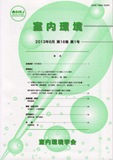All issues

Volume 16 (2013)
- Issue 2 Pages 69-
- Issue 1 Pages 3-
Volume 16, Issue 1
Displaying 1-3 of 3 articles from this issue
- |<
- <
- 1
- >
- >|
Original Papers
-
Melikizat ABLAT, Shuji FUJII, Naoki KAGI2013Volume 16Issue 1 Pages 3-13
Published: 2013
Released on J-STAGE: June 01, 2013
JOURNAL OPEN ACCESSSince Phthalic Acid Ester (PAE), which are representative substances of semi volatile organic compounds (SVOCs), have low vapour pressures, the possibility of being present in both the gaseous and particulate phases has been identified. In order to partition the gaseous and particulate phases of PAE in an indoor air, this study examined the applicability of the Denuder-Filter (D-F) sampling method which used VOC denuder for upstream and a quartz glass fiber filter for downstream. First, the theoretical values were determined for the penetration of the gaseous and particulate phases for a VOC denuder based on the Gormley-Kennedy Equation. Then, for verification, a method of generating exposure gas that was able to be in a stable concentration was studied. Next, experimental values were determined for the penetration of the gaseous and particulate phases to the denuder using the exposure gas and indoor suspended dust. With a flow rate of 5 L/min, most PAEs were adsorbed by the denuder, while particulate penetration ratio of particulate matter larger than 10 nm was about 88% or more. The results show that the gaseous and particulate phases could be partitioned. In addition, it was performed parallel measurement with both the Tenax sampling and the D-F sampling method for examination on gas-particulate phase partitioning fraction in indoor. The concentration became in order of DBP, DEHP, and DEP and without re-volatilization of PAE adsorbed on the denuder. PAE may have in large part of gaseous phase on more than 28°C of room temperature.View full abstractDownload PDF (1519K) -
Kazuyo TAKAHASHI, Yoshika SEKINE, Hidenobu FURUKAWA, Satomi ASAI, Haya ...2013Volume 16Issue 1 Pages 15-22
Published: 2013
Released on J-STAGE: June 01, 2013
JOURNAL OPEN ACCESSAcetaldehyde is known as one of the indoor environmental contaminants, and numerous emission sources have been reported. However, little consideration has been given to the influences of human skin gas on the indoor air concentration. This study aimed to estimate the contribution of human skin gas on the indoor air concentration levels of acetaldehyde based on the measurement of emission flux of acetaldehyde from human skin of volunteers using passive flux sampler methodology. As a result, emission rate of acetaldehyde from human skin of a single resident was much greater than that from human breath even after drinking alcohol. Although contribution of the human skin was estimated only 0.87-2.3 % of indoor air quality guideline level (48 μg m-3), the skin gas after drinking was suggested to be a source of odor of a room. These results lead a conclusion that human skin gas should be considered as an important emission source of acetaldehyde in indoor air, when occupied with more than drunk one person.View full abstractDownload PDF (1156K) -
Hiromi YAMADA, Kazuhiko MATSUSHITA, Shin-ichi TANABE, Motoya HAYASHI2013Volume 16Issue 1 Pages 23-34
Published: 2013
Released on J-STAGE: June 01, 2013
JOURNAL OPEN ACCESSIn addition to clarifying the indoor concentration when natural materials and industrial building materials are used and the indoor concentration decreasing effect due to formaldehyde adsorption, the purpose of this study is to clarify the validity of a measurement method for each construction phase as a method of identifying the cause of high chemical concentration. For this experiment, we built an experimental house from wall materials characterized by natural materials and from industrialized building materials and measured the concentration of formaldehyde (DNPH-HPLC method) and of VOC (sampling using Glass Prepacked ATD Tubes and GC-MS analysis) at each construction phase over a period of a year. As a result, we discovered an inflow of formaldehyde from inside the walls as well as indoor pollutants. In response to this, it is necessary to verify the emission rate of the materials on the outside of the airtight layer (for example, heat insulating materials and the back of the outer wall). An increase in the concentration of TVOC was apparent after construction of the wall materials and floor boards and a decrease over a relatively long period was not evident. It is necessary to consider TVOC concentration for VOCs Vaporization building materials, such as adhesives highlighted in the past, and also for constituents of the plastering material. It is also necessary to conduct measurements at each construction phase to identify the cause of emission (particularly measurements after carrying out wet construction using coating and adhesive) and to establish curing period from the measurement results.View full abstractDownload PDF (1971K)
- |<
- <
- 1
- >
- >|